Conducting a competitive keyword analysis for more (quality) traffic
Competitive keyword analysis is a fundamental aspect of any SEO strategy. By both understanding and implementing this process, businesses can leverage their competitors’ insights, enhance their own content strategy, and ultimately secure higher-quality traffic.
We’ll take you through the comprehensive process of conducting a competitor keyword analysis and then discuss its importance and practical applications. This article will also introduce you to essential competitor keyword research tools and guide you through the process of effectively identifying, analyzing, and prioritizing your competitors’ keywords.
Key Takeaways
Competitor keyword analysis is the process of researching the search terms your competitors are targeting to rank well in search results. It’s essentially a way to spy on their keyword strategy and identify opportunities to outrank them.
By analyzing competitor keywords, you can achieve the following goals:
- Identify competitors’ strengths and weaknesses in their content strategies
- Find profitable keyword opportunities you might have missed otherwise
- Create relevant content based on your audience’s pain points
- Improve your search engine ranking and attract high-quality traffic
Competitor keyword analysis involves three steps: collecting competitor keywords, cleaning and organizing them, and assessing their ranking difficulty.
Upon analyzing competitors’ keywords, digital marketers usually prioritize topics based on their business value, search volume, and user intent. The next step is to create a content plan that targets those high-value topics.
What is Competitive Keyword Analysis?
Competitor keyword analysis means carefully studying the keywords that your competitors use to rank prominently in search engines like Google. During this research process, you should:
- Pinpoint the top keywords your competitors are focusing on.
- Evaluate how well competitors are performing in search for those keywords.
- Figure out why they’re doing well and if it is worth competing with them.
The overarching objective here is twofold: firstly, to find opportunities to use similar keywords on your own website, and secondly, to uncover other keywords that aren’t being used much by your competitors.
By setting out on this journey, you’ll learn a lot—like changes in the market, the inner workings of your competitors’ strategies, and how to make your SEO game plan unique.
The Importance of Competitive Keyword Analysis
Why is competitor keyword analysis such a cornerstone for search engine optimization? Here are some of the main reasons:
- Understanding your competitors: Diving into their keyword strategy reveals the secrets of their online success. This kind of SEO competitor analysis provides a sneak peek into their content themes, SEO best practices, and areas where they might be struggling.
- Identifying opportunities: By comparing your keyword strategy with that of your competitors’, you can find and capitalize on missed opportunities and areas for potential growth. This shifts your focus to more lucrative and less competitive keywords.
- Planning your content: An in-depth keyword analysis is similar to having a compass for your content strategy. It shows you what your target audience is interested in, so you can create relevant content that resonates with them.
- Improving SEO and website traffic: Ultimately, by understanding what people are looking for, adapting to what your target audience wants, and homing in on the right keywords, your content stands a better chance at climbing search engine rankings. This not only boosts your online visibility but also brings in high quality visitors who are ready to engage with your brand.
So, mastering the art of competitor keyword analysis is not just about outperforming rivals but also about aligning closely with your audience’s needs. This sets the stage for steady online growth and engagement.
Competitor Keyword Analysis: A 3-Step Process
At its core, competitor keyword analysis offers insights into the keyword landscape of your competitors. This methodology provides you with a clearer roadmap for outranking your SERP rivals. It can be broken down into three key steps:
1. Collecting keywords: The best tools for competitor analysis allow you to see the keywords targeted by your competitors, which you can later use to expand your own list of keywords.
2. Cleaning and clustering keywords: Organize the collected keywords into meaningful groups based on shared characteristics or search intent. This will ensure that they align with your business goals.
3. Assessing keyword ranking difficulty: Determine the feasibility of ranking for chosen keywords by examining your website’s authority and the quality of its backlink profile.
Let’s take a closer look at each stage and some key things to remember when analyzing your competitors’ keywords.
Collecting Keywords
Understanding your competitor’s keyword strategy begins with collecting their SEO and PPC keywords and performing a keyword gap analysis. Consider using SE Ranking’s Competitive Research tool for this purpose. This competitive intelligence tool is specifically designed to help you perform a competitor website analysis.
To do this, go to the Competitor Comparison subtab. Here, you can find out what keywords you have in common with your top competitors, which ones are missing, and which ones are unique.
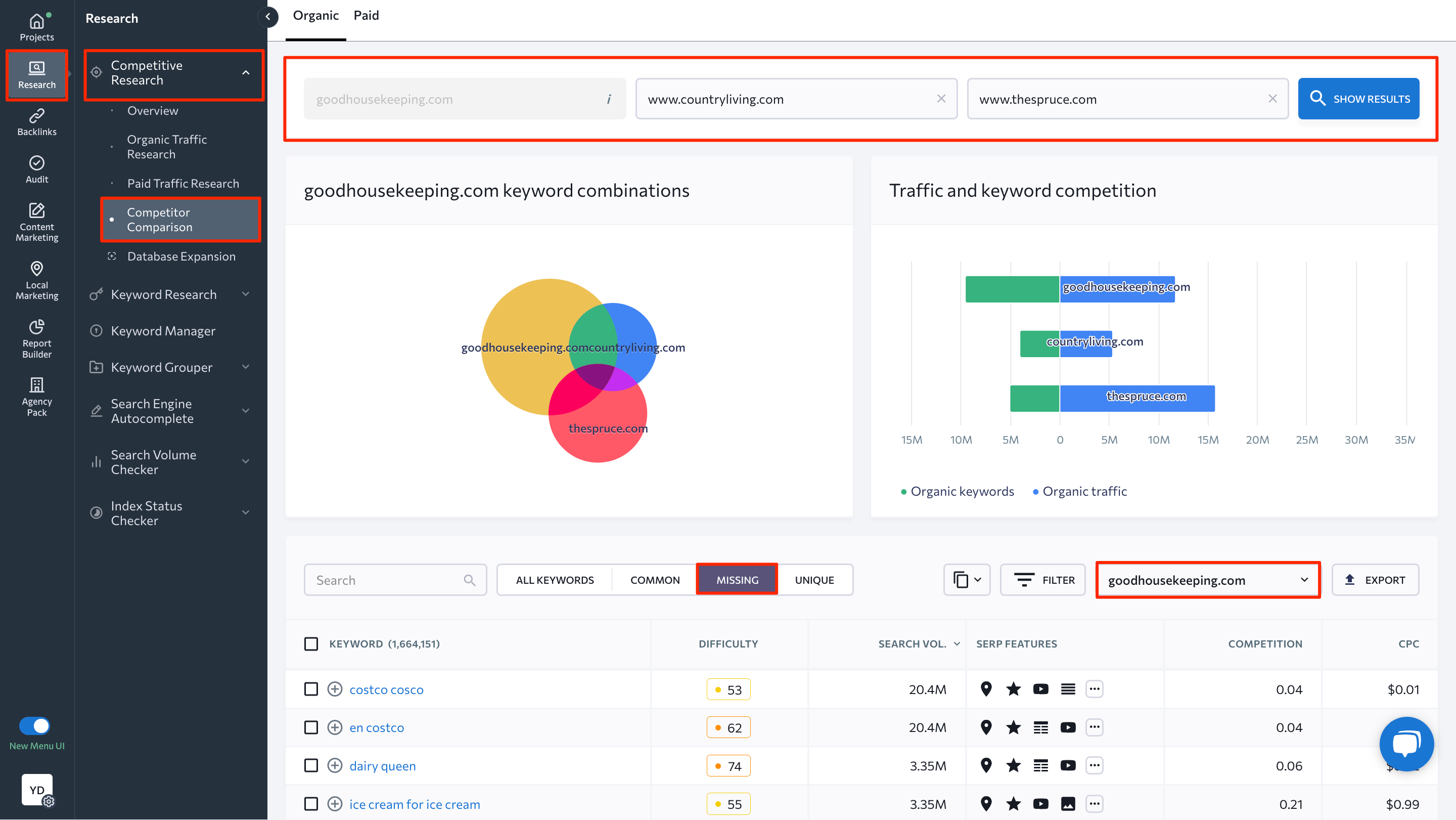
Just enter up to three websites for comparison, including your own, to compare the keyword lists of these domains.
Since your goal here is to expand your list of keywords, exploring the All keywords and Common tabs is not important at the moment. This is because these tabs will only highlight semantic overlaps. Instead, look for relevant keywords that are not targeted by your campaigns (aka keyword gaps).
At this stage, focus on the Missing tab to find words used by your competitors but not by you. Use filters to save yourself from the trouble of going through each keyword manually.
With the power of this data, you can gradually expand your list of keywords with queries that worked well for your top SERP competitors and use them in your own campaigns.
Once you finish, you can repeat the process with several other competitors.
If you want to detect trending/seasonal/new keywords your competitors started ranking for in the past month, make sure to use our Insights feature for your competitive analysis. Within the Competitors’ New Keywords section, you’ll be able to find the list of relevant search terms along with data on their search volume, keyword difficulty, traffic forecast, and so on.
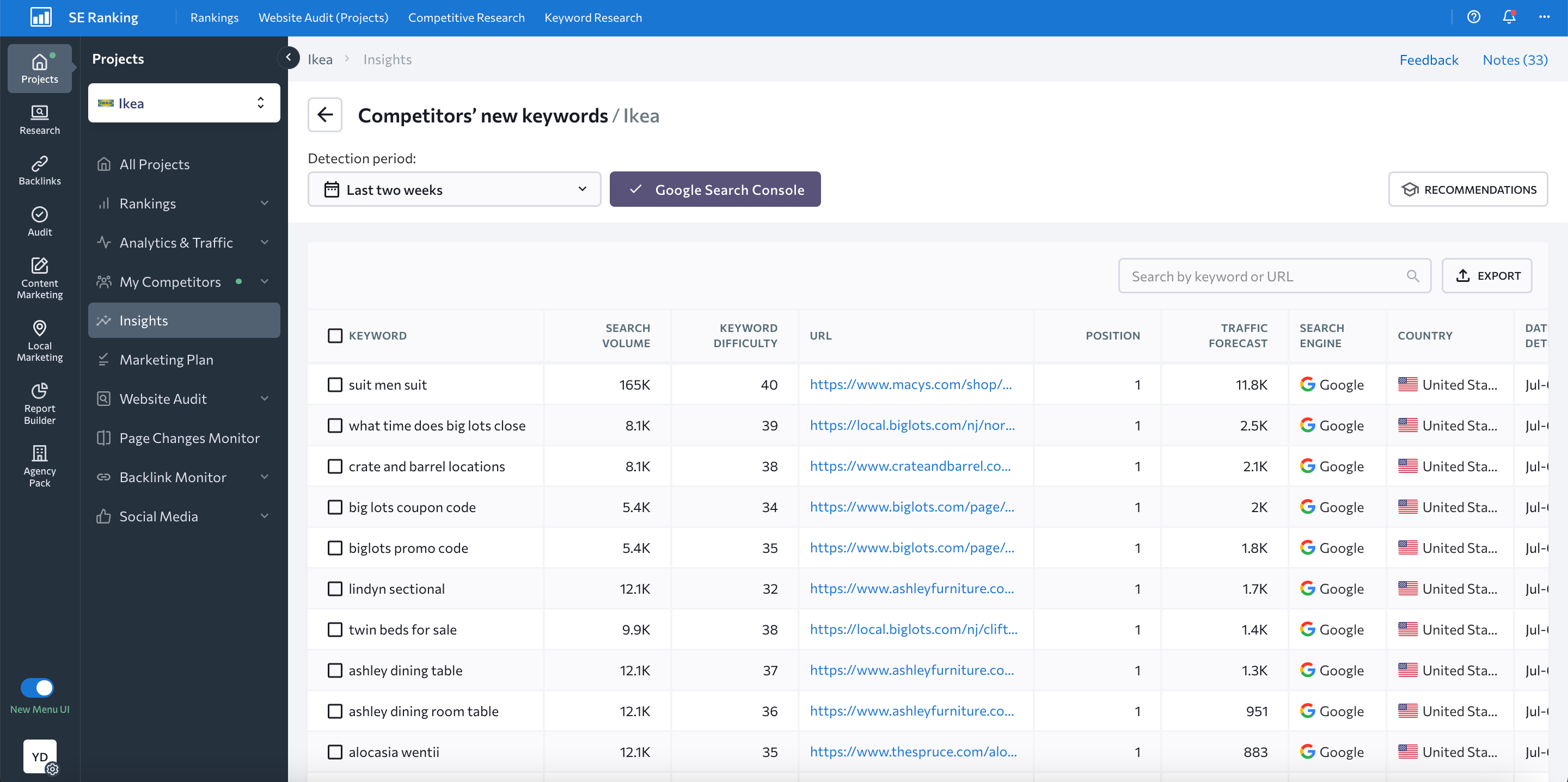
By exploring the list of these keywords, you can keep track of emerging trends within your niche, identify content gaps, and discover high-potential opportunities to improve your rankings and attract qualified traffic quickly.
Similarly, the Insights feature also has the Competitors’ New Pages section with a list of competitor URLs that recently started rankings in the top 30 (within the past month). You can also further explore this list and gain valuable insights on keywords that pages rank for, their search volume, difficulty, SERP position, and so on.
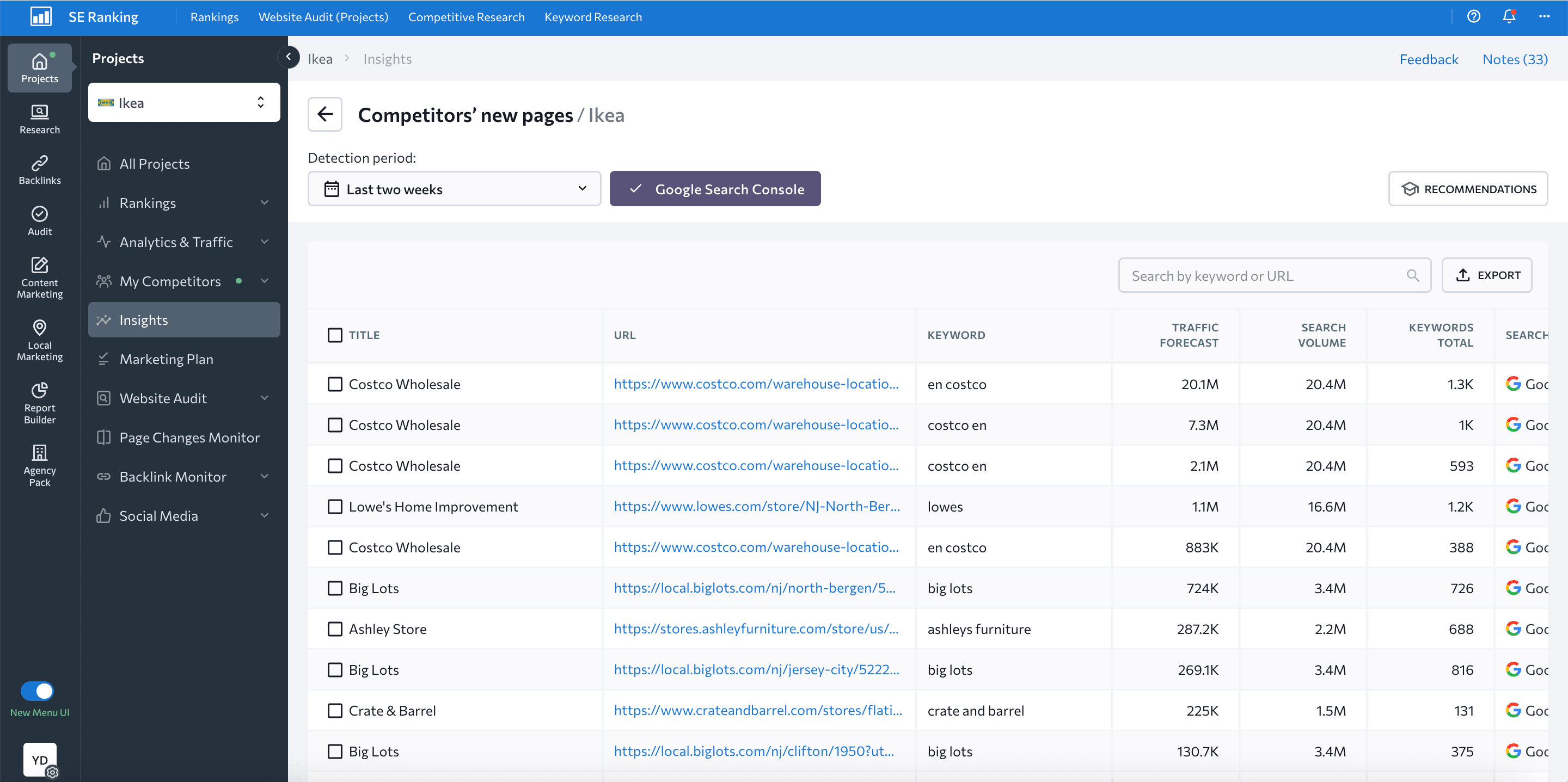
This will help you not only identify new trends as they arise but also find new niche players and optimize your marketing strategy to outperform them.
To dive deeper into the many different ways to uncover your competitor’s keywords, explore our detailed article on how to find competitors’ keywords. Here, we also explain how to use the Keyword Planner Tool to find competitors’ keywords worth targeting in Google Ads campaigns. Instructions for using the Bing Keyword Planner are provided as well.
Cleaning and Clustering Keywords
Once you’ve amassed a treasure trove of valuable keywords, it’s time to refine your list by removing the unnecessary ones and organizing the valuable ones. Clustering or grouping keywords is similar to categorizing them based on shared characteristics or intent.
SE Ranking’s Keyword Grouper can assist you in this process. Pay attention to keywords that align with your business’s goals. This strategic organization not only simplifies keyword analysis but also sharpens your insights into each keyword category.
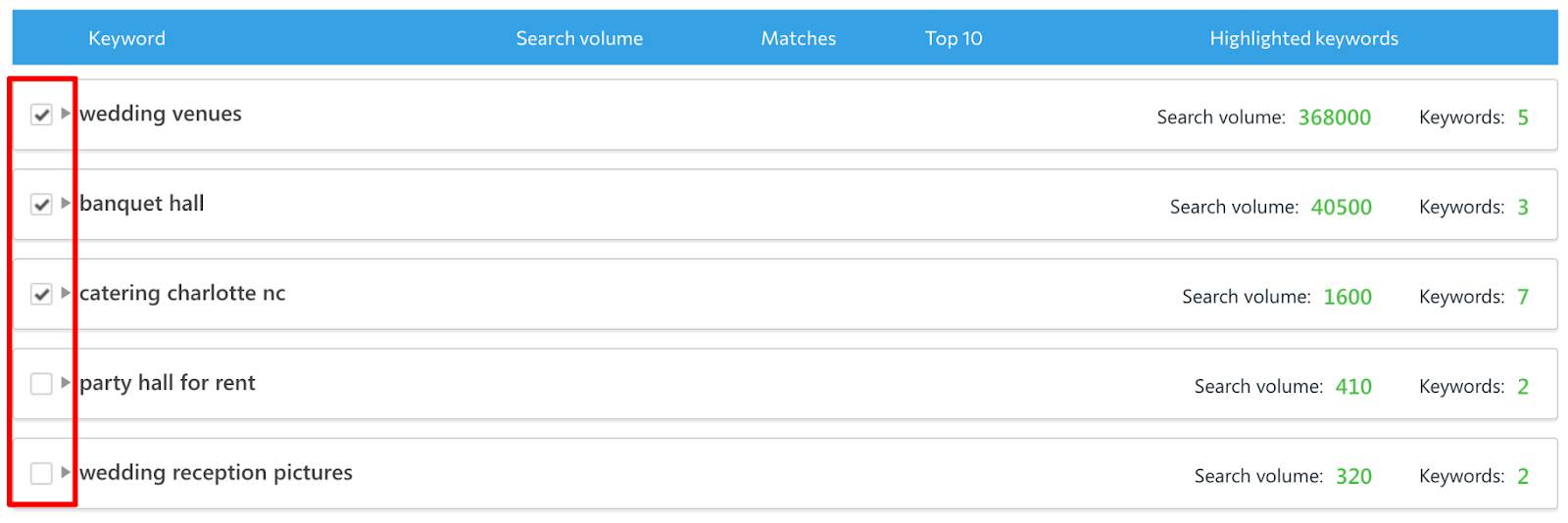
By doing this, you ensure that your time and resources are laser-focused on keywords that attract the right audience to your digital doorstep.
Assessing Keyword Ranking Difficulty
Within any keyword cluster, there’s always a shining star – the top-ranking keyword. In the example illustrated below, this keyword is ‘wedding venues’.
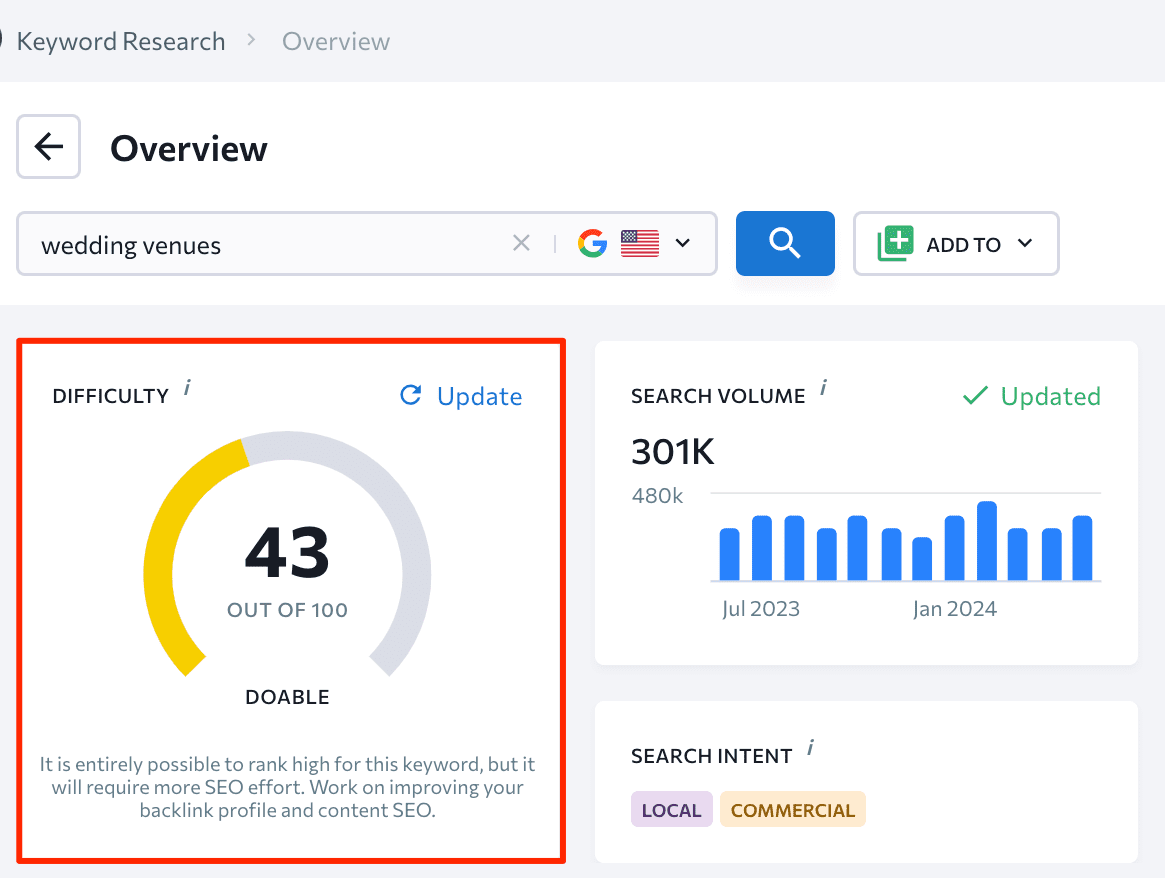
If you can get to page one and secure a top spot for this keyword, you’re likely to also dominate rankings for its less competitive counterparts within that cluster.
But when you’re assessing how difficult it will be to rank for a keyword on a specific SERP, be sure to consider the authority and backlink profiles of competitor websites.
A) Website Authority
In the grand arena of the internet, a website wears its authority like a badge of honor. It speaks to a website’s credibility and relevance, especially when it comes to specific search queries. Competing for keyword dominance can become an uphill battle if your website’s authority falls short compared to your SEO competitors.
In SE Ranking, a website’s authority is measured by its Domain Trust score. This score gives you an idea of how likely a website is to rank well in organic search by factoring in its referring domains and backlink history.
You can find your competitors’ Domain Trust scores in SE Ranking through several methods:
1. Enter a search query into the Keyword Research tool and go to Organic Results.
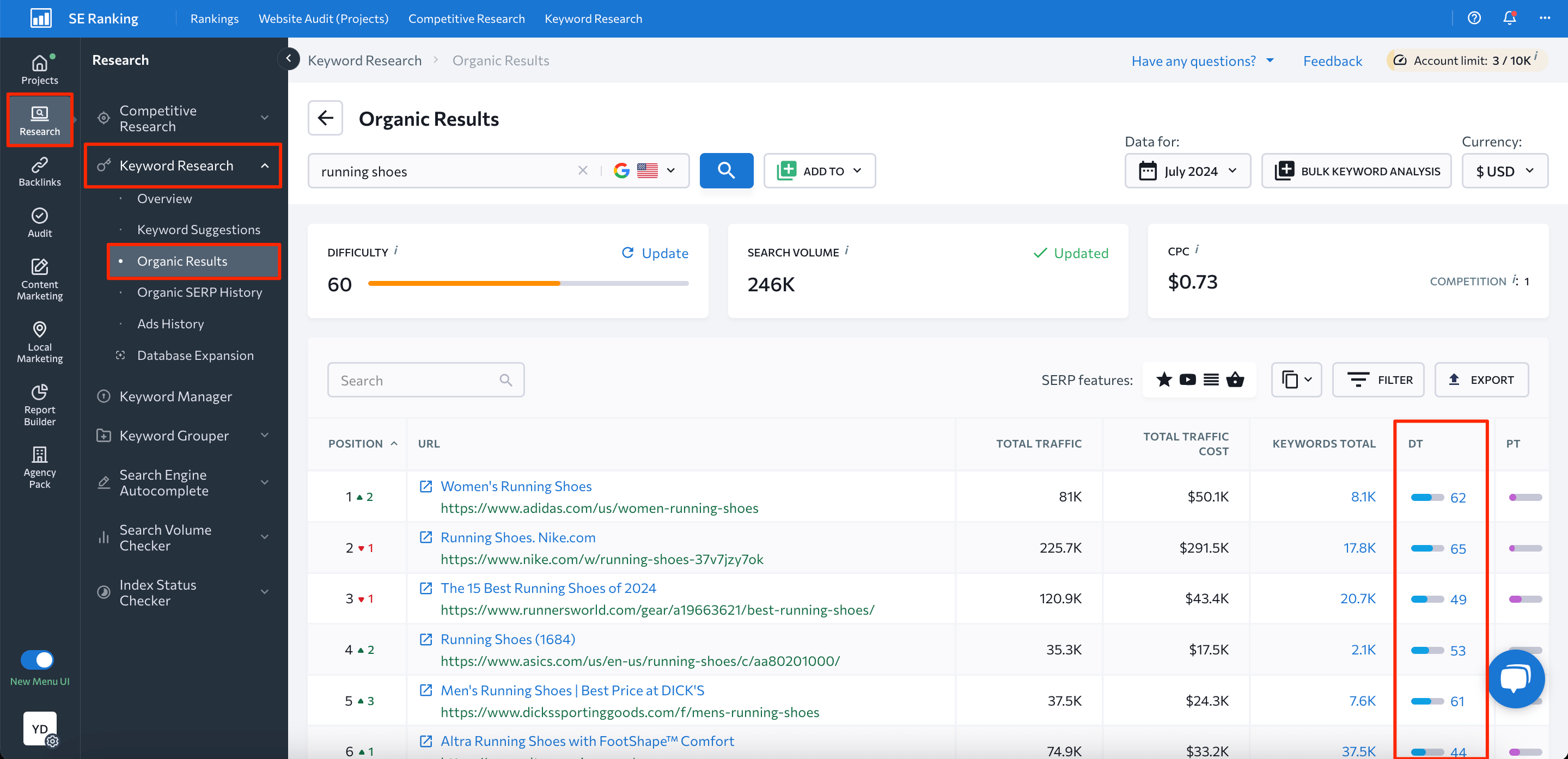
2. Use the SERP Analyzer tool to audit a keyword SERP, click on the +Add Metrics button, and analyze the results. Make sure only the Domain Trust metric is active.
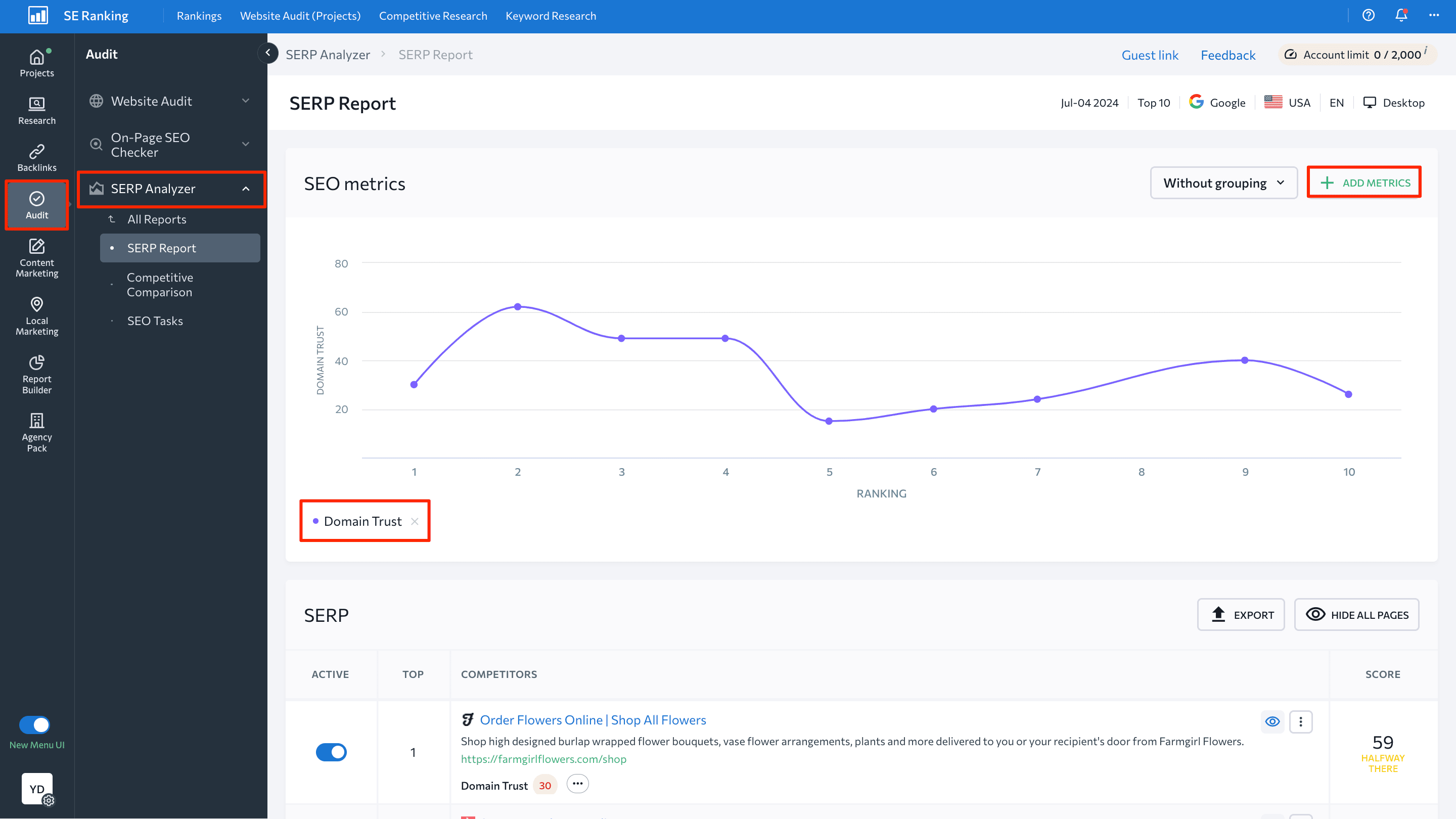
3. In the SERP Analyzer, go to Competitive Comparison, then to the On-Page Metrics tab, and scroll down to the Domain Trust part of the table.
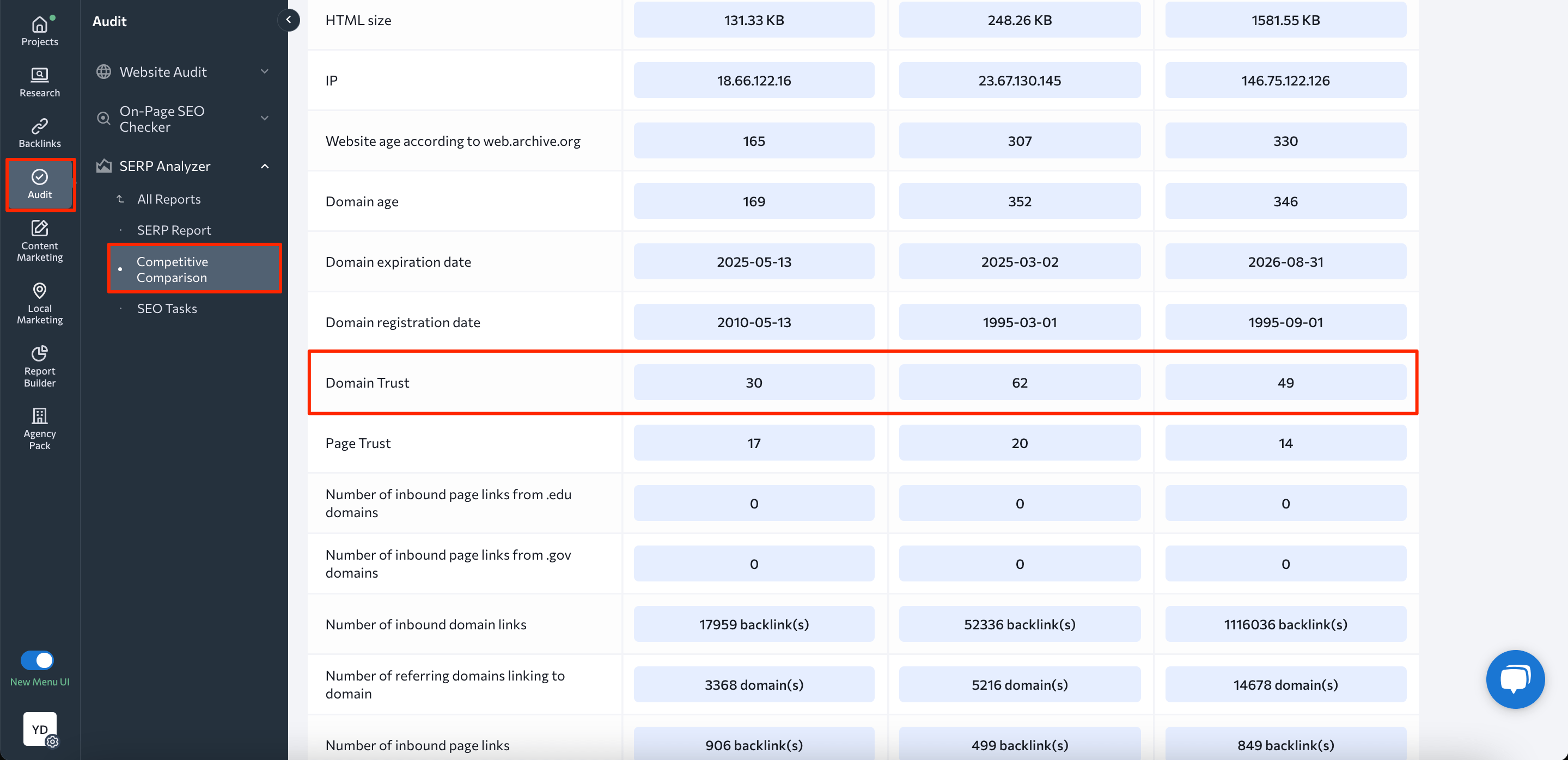
While our keyword tool provides a quick overview of a website’s core metrics, the SERP Analyzer lets you dive much deeper into data on websites.
But if your competitors’ domain authority scores seem to be too high, don’t see it as a reason to give up. Instead, view it as a challenge to shore up your website’s expertise on the topic. You can circle back to these keywords later. Meanwhile, zeroing in on less competitive subtopics within that keyword cluster can be a smart move.
B) High-Quality Links from Other Websites
Backlinks are critical to your ranking success. Even if you have a huge number of websites linking back to your site, not all of them will be top notch.
Before targeting a specific keyword, it’s crucial to examine the backlink profiles of the pages that rank highly for that keyword in the SERPs.
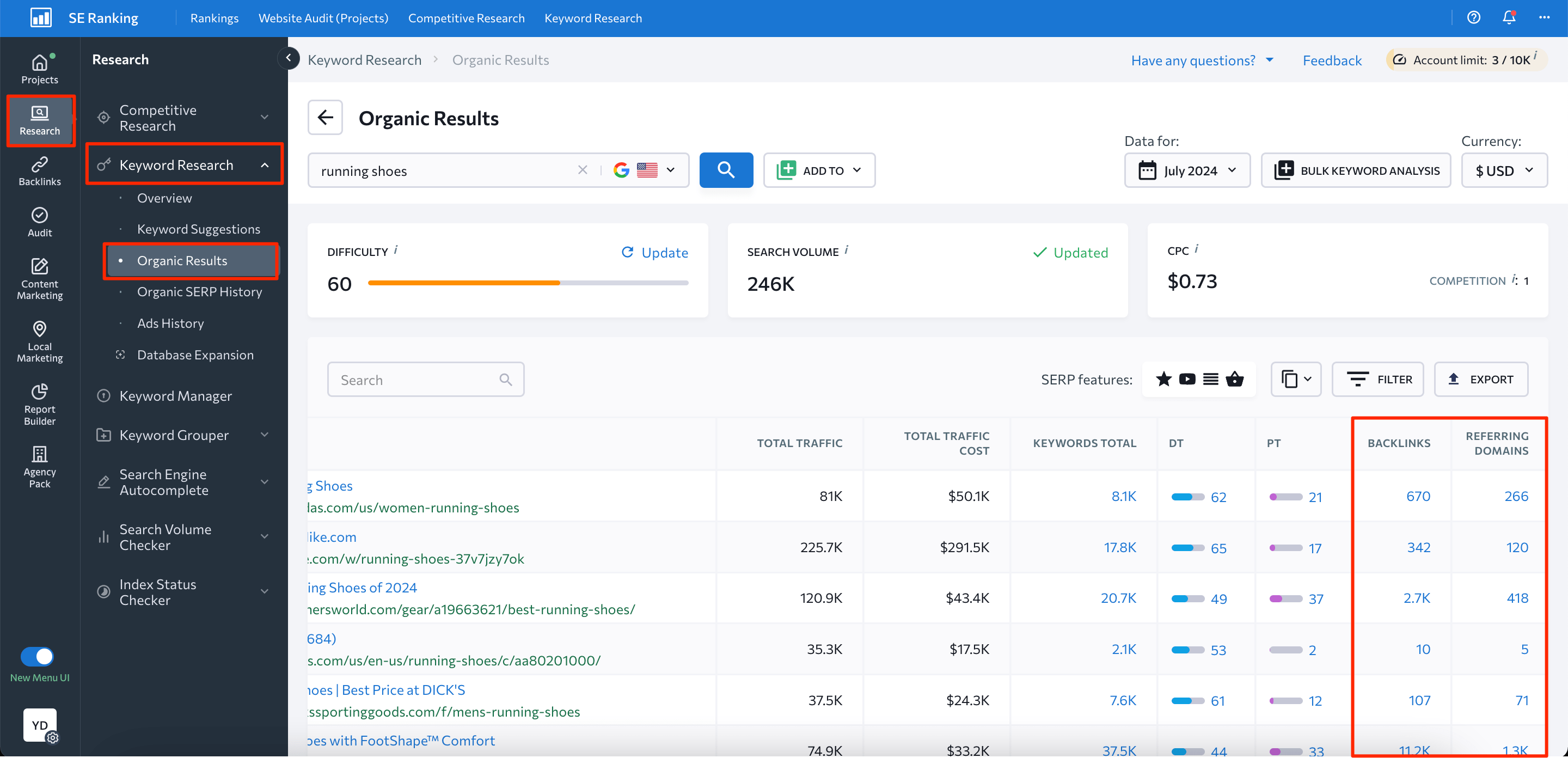
Pro tip: Even if a web page has many links pointing to it, its strength might be compromised if many of those links aren’t good or are marked as nofollow. So, moving such a page down from its top position might be easier than you think. When working with keywords, always be realistic. Organize your keywords based on when your goal timelines and plan ahead wisely.
Using Competitor Keywords to Your Advantage
Once you’ve analyzed your competitors’ organic keywords, it’s essential to take strategic advantage of this information. This means taking a comprehensive approach by prioritizing topics based on their business value, search volume, and user intent. It also means planning your content with your target audience and SEO in mind.
Prioritizing Topics Based on Keyword Research
Giving priority to certain topics not only helps in organizing your approach but also ensures that you focus on what truly matters for your business. Here are three key factors to consider:
A) By Business Value
The business value of a keyword is its potential to funnel revenue to your website or online platform. In simpler terms, you need to understand how interested your target audience, or ideal customer profile (ICP), is in that topic.
For example, if you’re in the business of selling computer parts, the keyword “buy 2TB hard drive” would undoubtedly carry high business value since the people who search it up are likely contemplating a purchase. On the other hand, a term like “what is a laptop” probably indicates that the searcher is in one of the initial stages of the buying cycle or not looking to buy at all. This would give it a lower business value.
Pro tip: To streamline the process and make it more actionable, consider assigning a numeric business value ranging from 0 to 3 to each keyword. In this case, a score of 0 would signify that the keyword has negligible business value, while 3 would mean that the keyword can significantly benefit your business.
B) By Search Volume
Search volume is a metric that shows how often a keyword is searched for in a month, on average. Generally, a higher search volume suggests more potential traffic to your content.
Nonetheless, higher search volume often means stiffer competition, so you need to weigh the pros and cons.
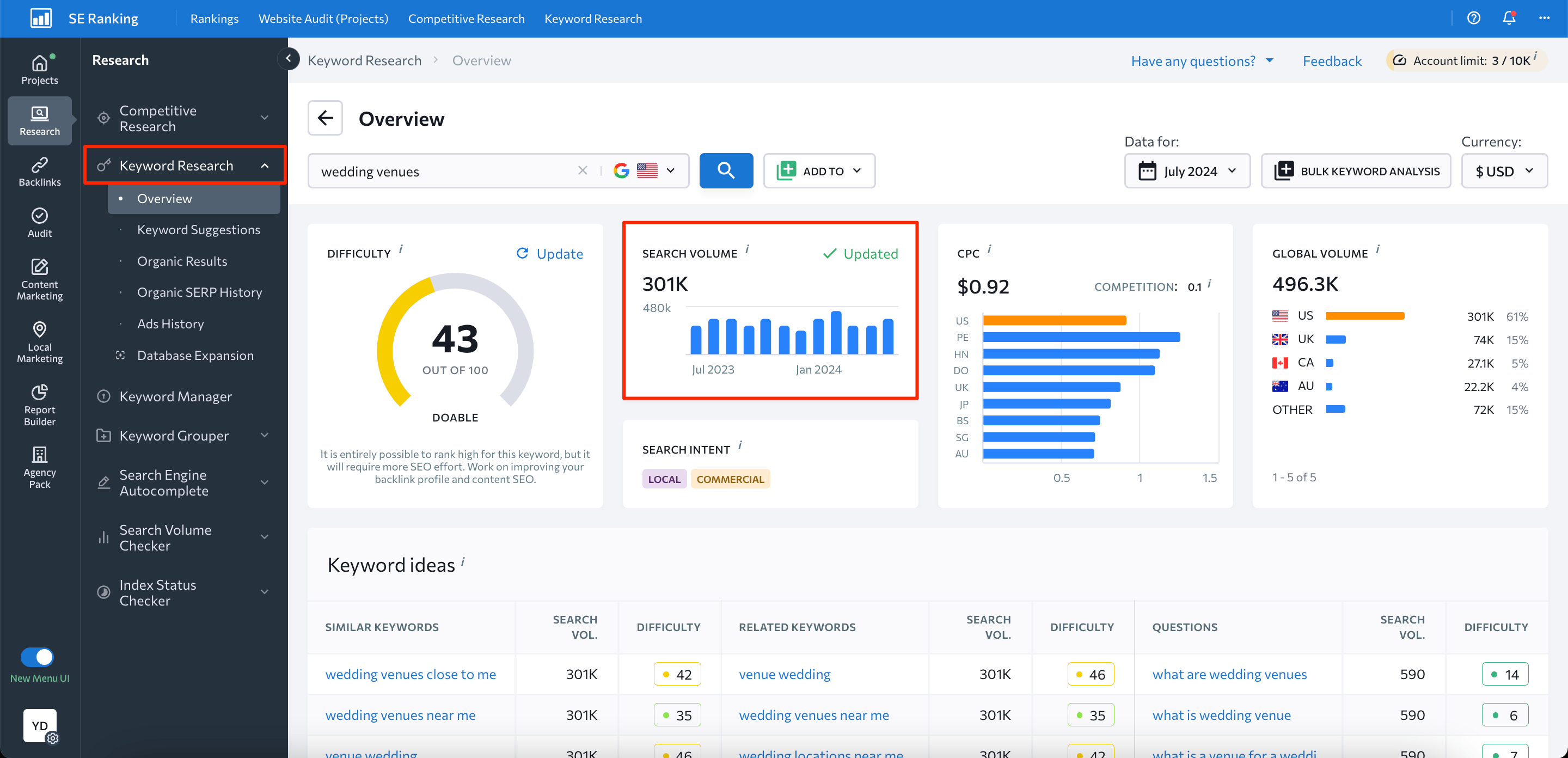
Tools like SE Ranking’s Keyword Research can help you get reliable and precise data on keyword monthly searches. This keyword explorer also offers a clear picture of how much traffic a keyword could potentially drive to your site.
C) By Search Intent
Understanding the intent behind a query is paramount because it allows you to tailor your content to directly address what users are seeking. This positions your content better in the digital landscape.
SE Ranking’s SERP Checker can be instrumental in this regard. It lets you assess the types of pages that rank for particular keywords, helping you understand user intent and refine your content strategy accordingly.
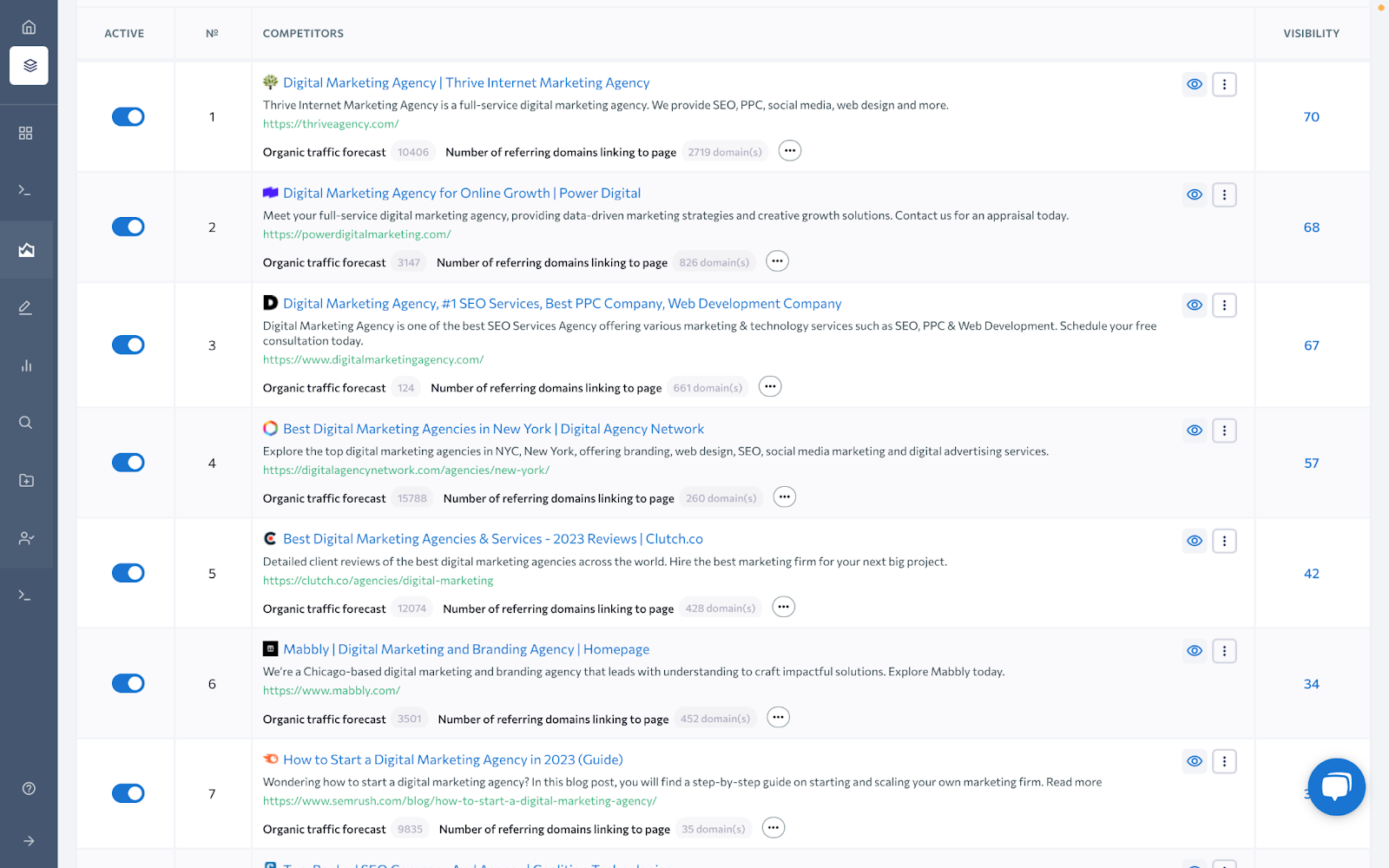
You can find data on a keyword’s search intent in SE Ranking’s Keyword Research tool.

Additionally, enter a competitor’s domain into the Competitive Research tool and scroll down on the Overview page until you find the Keywords by Intent block. Here, you can learn more about the specific keywords they use to satisfy different search intents. Just click on the number of keywords in each group.
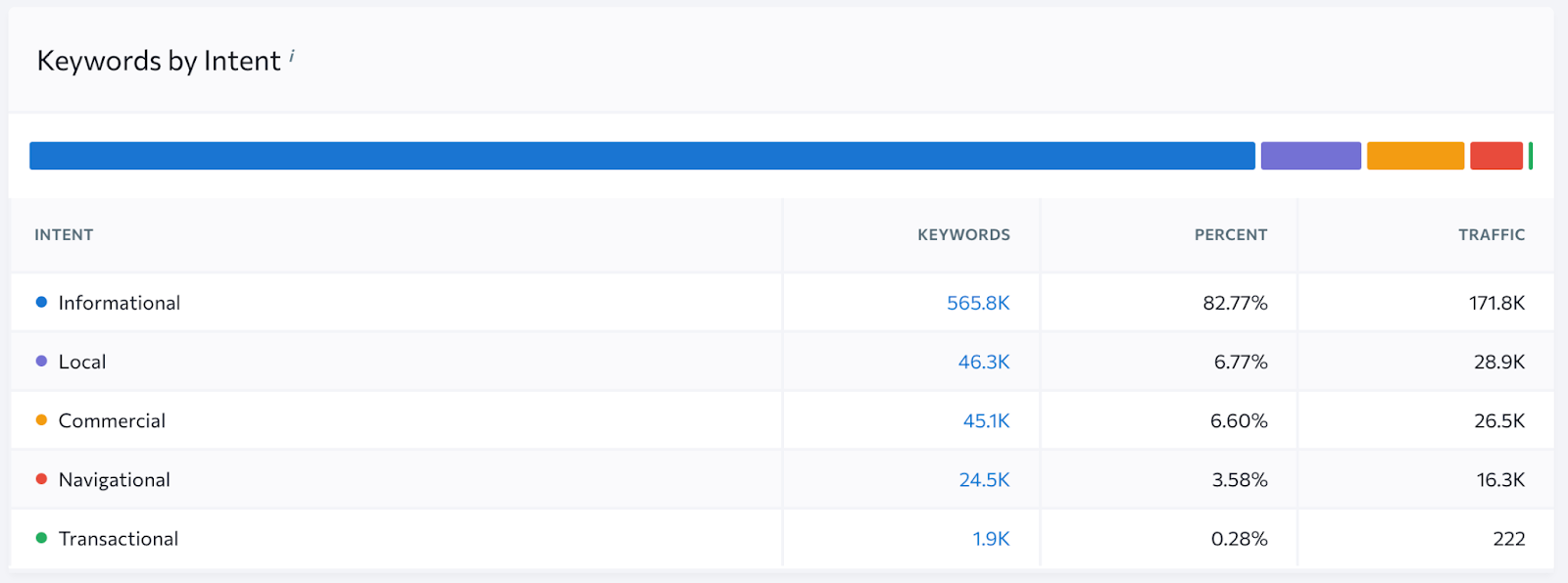
Furthermore, you can even analyze popular competitor web pages under the Organic Traffic Research → Pages section in terms of their keyword distribution by search intent.
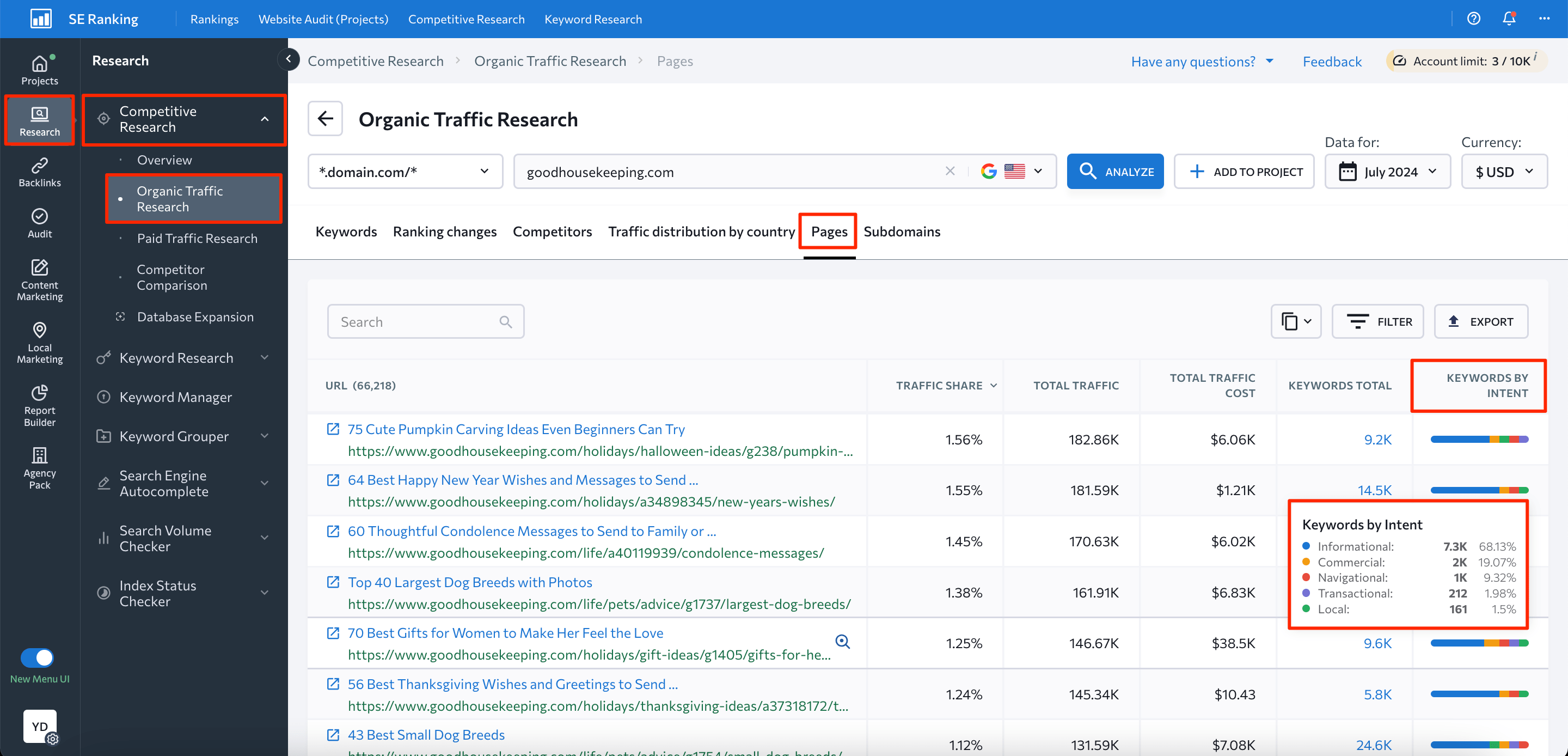
Leveraging Analysis Insights to Build a Content Plan
After carefully prioritizing topics, the next critical step is to create a content plan.
This planning process requires a clearcut strategy, including decisions about the kind of content to create, how often to publish it, and the most effective platforms for its distribution and promotion.
Additionally, it’s essential to be mindful of keyword cannibalization, which occurs when multiple pieces of content target the same keyword, potentially undermining your SEO efforts. Integrating SEO forecasting can also play a pivotal role, enabling you to predict and prepare for future trends and shifts in search behavior.
The overarching goal of this specific effort is to consistently produce content that addresses the specific needs and questions of your target audience. You want to gently guide them towards your company’s offering.
Summary
To recap, by analyzing and understanding the most promising keywords your organic competitors are targeting on their websites, you can improve the performance of your own website in search.
This, in turn, will help you reach the right people, move up in search rankings, and attract more visitors who are interested in what you’re selling. So, study what others are doing well, and use those tricks to make your site stand out.
